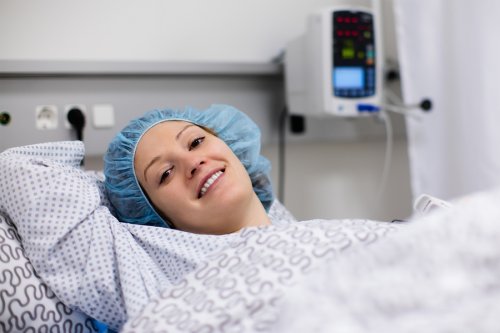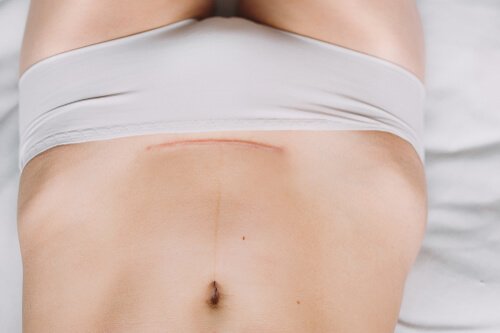Caring for Postpartum Stitches

Whether you’ve had a C-section or an episiotomy, the healing process for postpartum stitches is very important, as it can ensure faster recovery and prevent infections. We’ll tell you more about the necessary care in the following article.
Caring for postpartum stitches: C-section
The recovery of a woman who has undergone a C-section may be slower than that of a mother whose child was born through a normal delivery. In addition to the discomfort or pain, you must take care of the stitching included in this procedure.
Some tips to get through this stage in the best way are:
1. Take short showers
During the days that you have the C-section stitches, you won’t be able to bathe in a tub or take immersion baths. To clean yourself, you’ll have to take short showers and clean the wounded area with water and a neutral soap, in case you aren’t bandaged. The doctor may also prescribe you to use a special antiseptic soap.
2. Let the wound “breathe”
While it’s true that the dressing or bandage that you put on in the hospital avoids friction with your underwear or sheets and reduces pain, it’s also necessary for the wound to take a breath.
To do this, you must remove the bandages and leave the wound uncovered for a while. Be very careful and make sure you’re not breastfeeding nor sleeping with your partner when the area is exposed. Also, minimize your contact with any element.

3. Don’t wear tight clothes
Besides cotton underwear, when you still have the stitches, you can’t wear tight pants or anything with zippers. We also recommend not making any abrupt moves or strong efforts in order to avoid the stitches from coming undone or you hurting yourself.
During this phase, some actions may be difficult to execute. To get out of bed, for example, take your body to the edge, slowly lower your feet, and put a pillow on your belly before getting up.
Healing from postpartum stitches: episiotomy
During vaginal or natural birth, it’s sometimes necessary to make an incision in the perineum area — the one between the vulva and the anus — so that the baby can come out without any problems and thus avoid tearing the area.
Subsequently, this cut is sewed with stitches using a synthetic material that causes them to “fall” on their own and be reabsorbed. A thicker material can also be used, which would be removed by the doctor in about 10 days. This procedure is known as an episiotomy, which becomes a wound that requires healing after childbirth.
“The curing process for postpartum stitches is very important, as it can ensure faster healing and prevent infections.”
To make sure you heal properly from an episiotomy, it’s imperative to take care of the wound. When the mother is in the hospital, the health staff takes care of it, but when she is discharged, she must do it by herself at home or with her partner’s help.
Some tips to keep in mind for postpartum healing are:
1. Keep the area clean and dry
Every time you go to the bathroom you should wash thoroughly with fresh water. Don’t forget to dry off with a soft patting motion using a towel that doesn’t leave threads behind. Some women also dry themselves with a fan or even with a hair dryer set on cold.

2. Wash with water and salt
Certain doctors recommend this to accelerate healing. Of course, the water must be warm and you don’t have to pour too much salt; a handful is enough. When you’re finished, remember to dry off well.
3. Use special bandaging
As a first step, your underwear must be loose and of a cotton material. When sleeping at night, it’s advisable to remove excessive bandages to avoid moisture retention. In turn, pharmacies sell special wrappings that allow the area to breathe and prevents the stitches from sticking.
To summarize, whether the delivery was by C-section or an episiotomy was needed, it’s very important to avoid infections in the stitches. The obstetrician will indicate the appropriate treatment plan to accelerate the healing process and minimize any possible complications. Aim to follow it strictly and everything will turn out perfectly.
Whether you’ve had a C-section or an episiotomy, the healing process for postpartum stitches is very important, as it can ensure faster recovery and prevent infections. We’ll tell you more about the necessary care in the following article.
Caring for postpartum stitches: C-section
The recovery of a woman who has undergone a C-section may be slower than that of a mother whose child was born through a normal delivery. In addition to the discomfort or pain, you must take care of the stitching included in this procedure.
Some tips to get through this stage in the best way are:
1. Take short showers
During the days that you have the C-section stitches, you won’t be able to bathe in a tub or take immersion baths. To clean yourself, you’ll have to take short showers and clean the wounded area with water and a neutral soap, in case you aren’t bandaged. The doctor may also prescribe you to use a special antiseptic soap.
2. Let the wound “breathe”
While it’s true that the dressing or bandage that you put on in the hospital avoids friction with your underwear or sheets and reduces pain, it’s also necessary for the wound to take a breath.
To do this, you must remove the bandages and leave the wound uncovered for a while. Be very careful and make sure you’re not breastfeeding nor sleeping with your partner when the area is exposed. Also, minimize your contact with any element.

3. Don’t wear tight clothes
Besides cotton underwear, when you still have the stitches, you can’t wear tight pants or anything with zippers. We also recommend not making any abrupt moves or strong efforts in order to avoid the stitches from coming undone or you hurting yourself.
During this phase, some actions may be difficult to execute. To get out of bed, for example, take your body to the edge, slowly lower your feet, and put a pillow on your belly before getting up.
Healing from postpartum stitches: episiotomy
During vaginal or natural birth, it’s sometimes necessary to make an incision in the perineum area — the one between the vulva and the anus — so that the baby can come out without any problems and thus avoid tearing the area.
Subsequently, this cut is sewed with stitches using a synthetic material that causes them to “fall” on their own and be reabsorbed. A thicker material can also be used, which would be removed by the doctor in about 10 days. This procedure is known as an episiotomy, which becomes a wound that requires healing after childbirth.
“The curing process for postpartum stitches is very important, as it can ensure faster healing and prevent infections.”
To make sure you heal properly from an episiotomy, it’s imperative to take care of the wound. When the mother is in the hospital, the health staff takes care of it, but when she is discharged, she must do it by herself at home or with her partner’s help.
Some tips to keep in mind for postpartum healing are:
1. Keep the area clean and dry
Every time you go to the bathroom you should wash thoroughly with fresh water. Don’t forget to dry off with a soft patting motion using a towel that doesn’t leave threads behind. Some women also dry themselves with a fan or even with a hair dryer set on cold.

2. Wash with water and salt
Certain doctors recommend this to accelerate healing. Of course, the water must be warm and you don’t have to pour too much salt; a handful is enough. When you’re finished, remember to dry off well.
3. Use special bandaging
As a first step, your underwear must be loose and of a cotton material. When sleeping at night, it’s advisable to remove excessive bandages to avoid moisture retention. In turn, pharmacies sell special wrappings that allow the area to breathe and prevents the stitches from sticking.
To summarize, whether the delivery was by C-section or an episiotomy was needed, it’s very important to avoid infections in the stitches. The obstetrician will indicate the appropriate treatment plan to accelerate the healing process and minimize any possible complications. Aim to follow it strictly and everything will turn out perfectly.
This text is provided for informational purposes only and does not replace consultation with a professional. If in doubt, consult your specialist.








